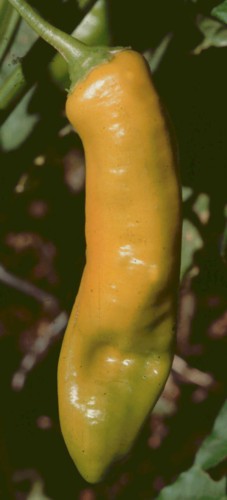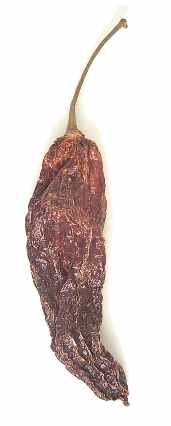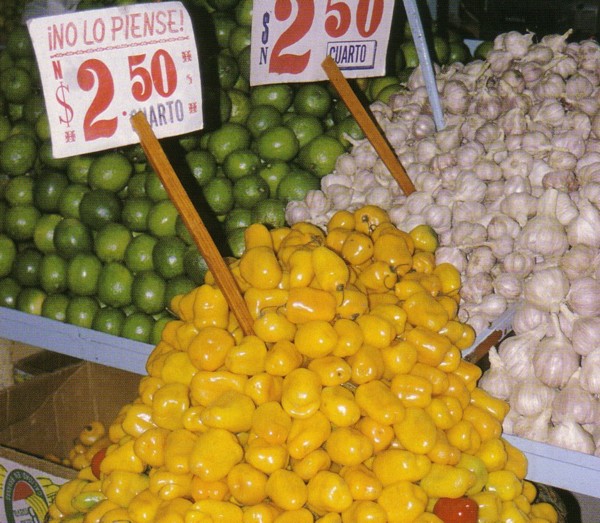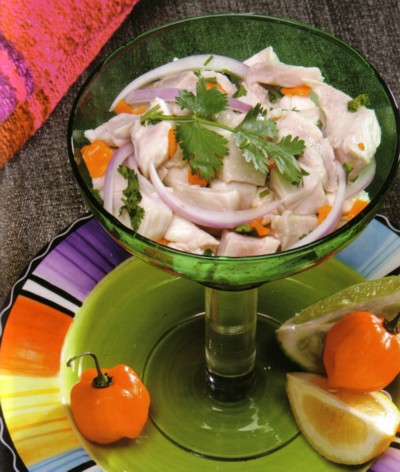By Scott Rose
 Machu Picchu |
Recipes:Stuffed Rocotos
|
Peru is a chilehead’s paradise. The country has over 300 different known types of chile peppers, and the nation’s regional cuisines, all chile-centric, try to outdo each other in firepower. A North American who cultivates a love for chiles might well be looked on by his sissy-tongued, bland-food-only neighbors as a whacko oddball, but in Peru, if you don’t love ajies, as chiles are called there, they know you’re not Peruvian.
No Peruvian town is complete without its “picantaria,” a type of restaurant whose name derives from a Spanish word for hot and spicy–even the country’s few McDonald’s locations serve their french fries with fiery yellow ají cream. But the people of this region have long loved chiles. The Mochica people, whose civilization flourished in northern Peru from 100 BC to about 900 AD, built pyramids, temples, palaces, fortifications and aqueducts; They also left behind a 2,000-year-old petroglyph showing a fish surrounded by chiles.
To the Incas, who thrived in this part of South America from the twelfth to the early sixteenth centuries, ají was a mythological character in spoken lore and poetry. And when modern archeologists unearthed thousands of Inca mummies in Puruchuco outside Lima, they found that many of the bodies had been buried in the company of foodstuffs, including generous servings of ají.
The Incas used an ingenious method of freeze-drying to preserve their chiles, which would then be ground into powders to be used as condiments. The mountainous areas around Machu Picchu tend to be cold at night and sunny and dry during the day. The ajíes would be spread out under cloths and allowed to freeze overnight. The following morning, they stomped on the chiles to remove moisture, and during the day the sun dried the ajíes. Not only do ajíes last longer when freeze-dried, they also acquire through the process markedly different and enchanting flavors.
The Peruvian writer El Inca, Garcilaso de la Vega, born in 1539 to a conquistador captain and an Inca princess, made many references to ajíes in his volumes of Peruvian history. “The people of my homeland are so enamored of ají that they won’t eat so much as a few raw vegetables without it,” he wrote. Garcilaso also described how seafood preserved with lime juice and ajíes was hauled long distances to supply Inca rulers with a historical version of the Peruvian specialty ceviche. Even Cuzco Cathedral, begun the year de la Vega turned 20, houses a painted representation of the Last Supper in which the feast includes roast guinea pig with papayas and ajíes on surrounding platters.
While it is not known in precisely what year Peruvians first described the fire of their ajíes as “gringo huanuchi” (hot enough to kill a Caucasian), we do know that in 1814 Friedrich von Humboldt wrote a political essay on the kingdom of New Spain, remarking that “The fruit of the chile is as indispensable to the native Peruvians as salt to the whites.” Over the last few centuries, many immigrant cultures have contributed elements of their own cuisines to Peruvian cooking: Spanish, African, Indian, Italian, Chinese and Japanese influences have greatly enriched the culinary landscape. Ask any Peruvian and you will hear that hot peppers are the very soul of Peruvian cuisine. But how does one make inroads in understanding a culture of over 300 different chile peppers? There are three basic types: ají amarillo, ají panca and rocotos.
 Ají amarillo, Capsicum baccatum, is the most frequently used in Peru. It grows in most every region and is available nearly all year. From four to six inches long, the pods taper to a point and are thin-fleshed. They start off green, ripen to a shiny yellow and can sometimes acquire an orange-red coloration in late maturity. Fruity in taste, with berry overtones and citrus aromas, ají Amarillo does pack a punch. One pod might measure 30,000 Scoville units and another 50,000, but none of them would be too tepid for Wilbur Scoville, were he alive to get seared by them.
Ají amarillo, Capsicum baccatum, is the most frequently used in Peru. It grows in most every region and is available nearly all year. From four to six inches long, the pods taper to a point and are thin-fleshed. They start off green, ripen to a shiny yellow and can sometimes acquire an orange-red coloration in late maturity. Fruity in taste, with berry overtones and citrus aromas, ají Amarillo does pack a punch. One pod might measure 30,000 Scoville units and another 50,000, but none of them would be too tepid for Wilbur Scoville, were he alive to get seared by them.
Ají amarillo is an essential ingredient of an authentic ceviche, the Peruvian national dish that consists of seafood cured in citrus juice, cilantro and red onion. Combined with onions, salt, garlic and other spices, the ají amarillo is also the basis for many different salsas used to accompany meats, seafood, poultry, potatoes and other vegetables.
The same chile pepper is sometimes called ají escabeche for its inclusion in dishes prepared as escabeches. An escabeche is made with fried fish, chicken or duck over which is poured a marinade of spices and seasonings, ajíes, red wine vinegar and olive oil. Once the sauce has had time to penetrate the fish or fowl, the escabeche is served cold.
In its dried form, ají amarillo is called ají mirasol. The dried pods might be charred to bring out their flavors while a paste made from them is used in soups, tamales and often in the absolutely delicious chicken dish ají de gallina. Though the function of ají amarillo is never merely decorative, cooks do enjoy the cheery yellow tone it lends their creations.

Ají panca is also Capsicum baccatum. Its long, curving stem looks more like a baccatum. Archaeological evidence suggests that people have been using this chile pepper since 6,500 B.C. Today the ají panca grows mainly in the coastal regions and is often used with seafood, though it is also an important addition to many rice dishes, soups and sauces.
About three to five inches long and about one inch across, the ají panca has medium thick flesh and a smoky berry flavor with fruity overtones adding up to an aromatic taste with mild but very persistent heat. The pods mature from green to yellow or deep red or burgundy. Upon drying they take on a rich chocolate brown coloration.
The rocotos, Capsicum pubescens, are an extraordinary ají. Having the approximate size and shape of small bell peppers, they are also exceptionally hot. Red or yellow on the outside, rocotos have unique black seeds. One online source for bottled, preserved rocotos with their seeds carries the warning “Muy picante. Keep out of the reach of children.”
 Rocotos are native to the valleys of the Andean highlands. The plant is bushy in formation, its blooms white at the center with a purple edge; like all pubescens, its leaves are hairy. Peruvians especially prize rocotos because the chiles’ tropical fruit overtones combine with a heat that works only on the taste buds and not on the digestive system.
Rocotos are native to the valleys of the Andean highlands. The plant is bushy in formation, its blooms white at the center with a purple edge; like all pubescens, its leaves are hairy. Peruvians especially prize rocotos because the chiles’ tropical fruit overtones combine with a heat that works only on the taste buds and not on the digestive system.
In their dried, powdered and paste forms, rocotos are used to flavor sauces and soups. As Doris Platt Rodriguez, the Peruvian owner of the restaurant Andina in Portland, Oregon says, “a sauce made with rocoto is the hot sauce por excelencia. Placed at the center of the table, a rocoto sauce will be used by Peruvians on virtually any food.”
The ultimate dish using this ají is rocotos rellenos, or stuffed chiles, a specialty of Arequipa in the Andes of southern Peru. Prepared with ground beef, egg, olives and spices, and topped with melted cheese, a rocoto relleno is fit to be the pride and joy of anybody who can consume it without reaching for a glass of milk or a slice of bread. While fresh rocotos are rarely available in commercial markets in the U.S., the plant can be cultivated and will bear fruit in many parts of North America. The Web site www.rocoto.com is an excellent resource for growing information and seeds.
Most any Peruvian restaurant in the U.S. serves ají-rich offerings, though if you enjoy the heat you should make mention of your preferences to your servers because as a rule they tone things down to suit the tastes of the typical heat-challenged American. Together with Andina’s head chef Emmanuel Piqueras Villaran, Doris Platt Rodriguez has gained particular distinction in the food world by spearheading the movement of Novoandina cuisine, which gives a light and haute twist to all things Peruvian.
At Andina it is possible to go from soup to nuts with ajíes in every course. The restaurant’s chief bartender Greg Hoitsman, who has traveled extensively in Peru, invented a drink named for an Incan fortress, the Sacsayhuaman. Made with rocoto-infused vodka, passion fruit puree, sugar and cilantro, the Sacsayhuaman has proven popular for the heated zing in its aftertaste. American patrons, unable to pronounce the drink’s true name, have taken to calling it the Sexy Woman.
 Rocotos in the Market
Rocotos in the Market
Beyond ají amarillo, ají panca and rocoto lies a universe of Peruvian chile peppers to be savored. Botanists exploring the forests are still finding hitherto undiscovered ajíes. While there might not be room to mention all the known types in this article, I would be remiss were I not to point out that among the very hottest is the pinguita de mono ají, the little monkey penis chile pepper.
Stuffed Rocotos

This recipe is a signature dish of Arequipa, a city spectacularly located in the Andes of southern Peru. Famous throughout the country, it has become a national dish, right behind ceviche and ají de gallina. The Peruvians typically accompany stuffed rocotos with beer, although a red wine is also appropriate. Note: This recipe requires advance preparation.
6 rocotos (large jalapenos may be used as a substitute)
2 tablespoons vegetable oil
1 medium onion, finely chopped
3 cloves garlic, minced
1/2 pound ground beef
1/2 teaspoon ground cumin
1/4 cup pitted olives, chopped
1 teaspoon salt
2 teaspoons raisins
1 egg, lightly beaten
6 yellow potatoes, boiled and cut in half
1 cup grated mozzarella or Gruyere cheese
1/4 cup milk
Freshly ground black pepper to taste
One day prior to serving, cut the tops off the rocotos. The tops may be saved as a garnish. Remove all seeds and veins. Soak the rocotos for 24 hours in a bowl of water with 2 tablespoons salt, changing the water at least twice.
Heat the oil in a frying pan, add the onions and cook until tender. Add the garlic and fry for 2 minutes. Add the meat and cumin and fry until cooked. Add the olives, salt, raisins and the beaten egg.
Stuff the rocotos with this mixture.
In a glass baking dish, arrange the rocotos and potatoes. Add the milk and arrange the cheese atop the rocotos.
Bake at 400 degrees F. for 40 minutes.
Yield: Six servings as an appetizer
Heat Scale: Hot
Salsa Criolla Limeña
Salsa Criolla is an onion and ají-based sauce that can be found at the center of most Peruvian tables. It is used as a condiment for all meats, seafood and vegetables.
2 red onions, julienned
Juice of 4 Peruvian limes or Key limes
2 very finely chopped Peruvian chile peppers such as fresh ají panca (or substitute serranos)
2 teaspoons chopped fresh cilantro or parsley
1/4 teaspoon white vinegar
1 teaspoon olive oil
Sea salt
Freshly ground black pepper
After julienning the red onions, place them in a bowl with salted water. Stir 1 minute, then leave the onions in the water an additional 5 to 10 minutes, then strain them and let them partially dry. (This process of washing onions, typically Peruvian, takes the strong edge off them and leaves them with an improved flavor.)
Place the washed onions in a container, squeeze the lime juice over them and then stir in the remaining ingredients.
This salsa criolla may be spooned over pork, red meat, duck, chicken or seafood. A piece of bread soaked in it is exquisite; Stirred into a soup, it gives a delightful piquancy.
Yield: 1 to 2 cups
Heat Scale: Medium
Ají de Gallina
(Peruvian Spicy Chicken)
The very name of this dish, ají de gallina, tells you that it should be good and picante. It is one of the classic showcases for ají amarillo, with the yellow Peruvian chili peppers lending both a fruity heat and a lovely yellow hue to the preparation. Dry champagne or white wine makes for an excellent accompanying drink.
1 4-pound chicken
4 slices of bread with the crusts trimmed
1/2 cup of oil
1 large onion , finely chopped
2 teaspoons ground garlic
3 rocotos, or 6 serrano chiles, seeds and stems removed, pureed
Salt and freshly ground black pepper, to taste
1/2 pound chopped walnuts and/or pecans
4 ounces grated Parmesan cheese
1 large tin of evaporated milk
6 yellow potatoes, cooked and halved
Green olives and hardboiled eggs, for garnish
Cooked rice
In a large pot of salted water, simmer the chicken until cooked through. Remove the meat from the pot but reserve the cooking water. Remove the meat from the bone and chop or tear it into bite-sized pieces.
Soak the bread in the chicken cooking water.
Heat the oil in a saucepan and fry the onion, garlic and chile peppers until golden. Add the chicken broth-soaked bread. Cook over low heat for 10 minutes and then add the chopped nuts, grated cheese and chopped chicken. Add the evaporated milk 3 minutes before serving.
Yield: 6 servings
Heat Scale: Medium
Red Snapper Ceviche
 Photo by Norman Johnson
Photo by Norman Johnson
More than any other dish, ceviche is the plato nacional of Peru. Though the recipe given here makes use of one fish only, any number of seafood items including other fishes, scallops, shrimp, octopus and crab may be used singly or in combination in preparing a ceviche. Many chefs will add some white wine to the mixture; the Ecuadorian version of ceviche calls for olive oil. Peruvians like their ceviche fiery hot, so in the interest of authenticity, don’t skimp on the diced chiles.
1 pound red snapper filet
Juice of 8 limes
Juice of 2 lemons
Various Peruvian chile peppers; 2 habaneros make a good substitute
1/2 cup chopped fresh cilantro
1 large red onion, cut in julienned strips and then soaked in cold salted water
1 tablespoon salt
1 teaspoon fresh ground black pepper
Cut the snapper filets into pieces about 1 inch long and 1/2 inch wide. Do not use pieces any larger than that, as they will not be properly cured by the citrus juices.
In a large stainless steel bowl, marinate the fish in the lime and lemon juices. Cover and let sit for one hour.
Chop the chiles, removing any seeds, and soak the chiles in a bowl of cold water. Julienne the red onion and soak in another bowl of cold water.
Add the chiles and onion to the fish, mix well and refrigerate for an hour before serving.
Yield: 4 servings
Heat Scale: Varies, but usually hot




